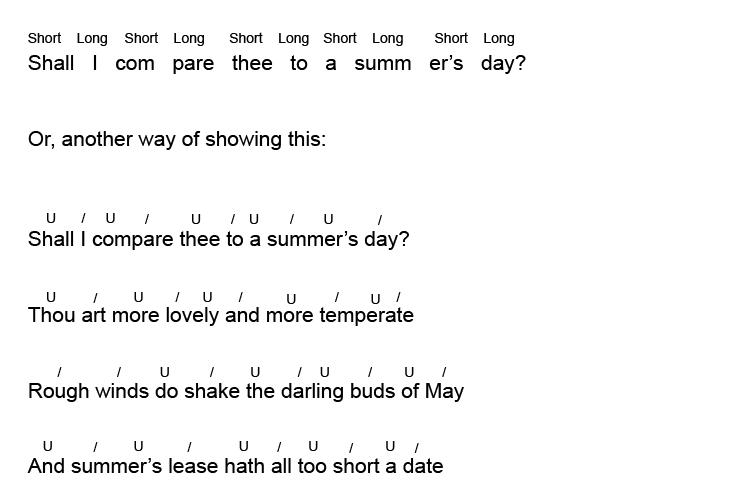How to Write a Sonnet: Tips and Examples

A sonnet is a poem of 14 lines using formal rhyme schemes. However, before William Shakespeare popularized this type of poem, the term could be applied to any short lyrical poem.
Because a sonnet is quite adaptable to different purposes, it is an excellent way to express a singular feeling or idea. Its versatility allows a poet to express their feelings about love, nature, or even politics.
What Is the Format of a Sonnet?
Before you can start writing your own sonnet, we should explore its characteristics. Derived from the Italian word sonetto, the sonnet is written in iambic pentameter, which consists of one short (or unstressed) syllable followed by one long (or stressed) syllable.
Sonnets have 14 lines, which can be broken down into four sections called quatrains. It also has a strict rhyme scheme—for a Shakespearean or English sonnet, this pattern is abab cdcd efef gg. There are other sonnet forms like the Petrarchan, Spenserian, Miltonic, and the stretched sonnet.
A rhyme scheme is the ordered pattern of rhymes at the ends of a poem’s line or verse. In the English sonnet, for example, lines 1 and 3 rhyme (a), as do 2 and 4 (b).
Does a sonnet have to be 10 syllables?
In English, sonnets typically contain 10 syllables per line, with 5 “beats” (the stressed syllables) per line. However, the rules for sonnets in modern poetry are a bit more flexible than they were in the days of Shakespeare.
How to Write a Sonnet
Some people might find writing sonnets to be daunting task—not surprising, since search results for the term include examples like Shakespeare’s Sonnet 18.
But don’t let the beauty of these classics intimidate you! Here is our simple guide to writing a sonnet that can walk you through each step.
Does a sonnet have to be about love?
The best thing about writing a sonnet is the amount of freedom it gives you in terms of theme. Think of a single idea for your sonnet, whether it’s a feeling, a thought about life, or about people. You might even find inspiration in books you’ve read or even political issues.
Use Descriptive Language
Make sure to be as visual as you can in expressing the topic or theme throughout the sonnet you are writing. Use creative imagery that explains the idea of your sonnet to your readers as clearly as possible.
However, if you are using figurative language, avoid overly abstract or ambiguous terms that your target audience would find hard to understand.
Choose a Specific Rhyme Scheme
Of course, your sonnet must rhyme, right? The next thing to do is figure out a rhyme scheme for your poem. There are other rhyme schemes aside from the more common Shakesperean.
The Petrarchan rhyme scheme sees its first 8 lines follow an abbaabba format, while the rest follows a varied rhyme scheme. Therefore, the Petrarchan rhyme scheme can provide a more flexible alternative to the Shakespearean.
The Miltonic sonnet also uses the Petrarchan rhyme scheme, but does not have the stanza break between the octave (set of 8 lines) and the sestet (set of 6 lines). A Spenserian sonnet, on the other hand, uses the abab bcbc cdcd ee rhyme scheme. Lastly, the Stretched sonnet is a more modern type of sonnet. It does not limit you to 14 lines, and some actually reach up to 16 lines.
Below, you’ll see an example of a Shakespearean sonnet’s rhyme scheme, taken from Sonnet 27 by the man himself.
| Sonnet 27 by Shakespeare Weary with toil, I haste me to my bed, A The dear repose for limbs with travel tired; B But then begins a journey in my head, A To work my mind, when body’s work’s expired: B For then my thoughts (from far where I abide) C Intend a zealous pilgrimage to thee, D And keep my drooping eyelids open wide, C Looking on darkness which the blind do see: D Save that my soul’s imaginary sight E Presents thy shadow to my sightless view, F Which, like a jewel hung in ghastly night, E Makes black night beauteous and her old face new. F Lo, thus, by day my limbs, by night my mind, G For thee, and for myself, no quiet find. G |
Shakespearean vs. Petrarchan
Here’s a quick summary of the 2 most common sonnets, the Shakespearean (or English) and the Petrarchan (or Italian) and their main differences.
| Shakespearean | Petrarchan |
| • uses the abab cdcd efef gg pattern • divides the sonnet into four parts: 3 quatrains and a couplet • the last two lines function as a resolution or a volta |
• uses the abbaabba for the first 8 lines • divides the sonnet into 2 parts: octave (8 lines) and sestet (6 lines) • turn comes as the lines transition from the octave to the sestet |
Iambic Pentameter
In basic iambic pentameter, a line would have 5 feet of iambs, which consist of an unstressed syllable followed by a stressed syllable. Your sonnet needs to contain 5 “feet,” or iambi. Pentameter means 5, and iambic pentameter simply means 5 feet.
Why Write a Sonnet
If you want to try your hand at poetry or exercise your creativity, try writing a sonnet. The possibilities are endless, but there’s also enough structure that the freedom isn’t overwhelming.
It might take a few revisions here and there to make sure your poem has the right measurement while ending with the correct rhyming word, but the beauty of the final product can be stunning.
Did you find this post helpful? Let us know in the comments below!

Comments
Post a Comment